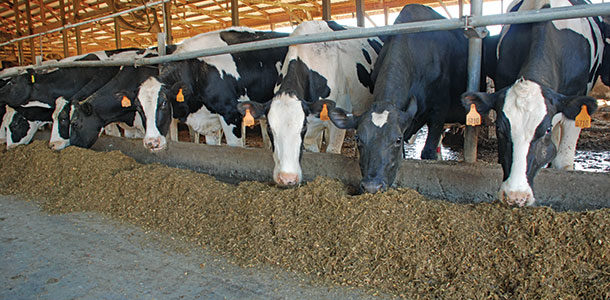For the first time in several years, the prices of corn grain and many corn byproducts are at favorable levels that encourage increased use of these ingredients in dairy diets. Corn distillers grains are particularly appealing because they offer both a higher protein and higher energy content, so you get more bang for your buck. However, the higher energy or fat content, which is largely due to the corn oil in the distillers, also can be quite variable.
In fact, it can range from a low of 2 percent to as much as 12 percent depending on how the corn was handled during ethanol production. This variability can wreak havoc on milk fat.
That’s because the corn oil in distillers grains contains a high level of polyunsaturated fatty acids (PUFA). Other feed ingredients, including some types of bakery byproducts, soybeans, cottonseed, expeller-processed oil meals, brewers grains, corn gluten feed and some specialty fat supplements, can also contain higher levels of PUFA.
In the rumen, PUFA are subjected to biohydrogenation by rumen bacteria. If the process of biohydrogenation is altered (and certain diets can do this), it can cause the accumulation of trans-fatty acids that depress milk fat synthesis.
It is unlikely that one single dietary factor causes the accumulation of trans-fatty acids and milk fat depression. However, what we have learned in the past few years is PUFA levels and rumen-degradable starch interact.
In other words, high PUFA levels, in combination with high rumen-degradable starch loads and lower ruminal pH, appear to increase the severity of low milk fat. This is likely due to resulting shifts in rumen microbial populations.
The good news is that it is possible to solve, and even sometimes predict, milk fat depression problems using technology that measures rumen-degradable starch in your feeds. Knowing this and the amount of PUFA in the diet can lead to greater stability in milk components.
Help for solving problems
Recently, a nutritionist approached us with a milk fat problem he was experiencing in one of his customers’ herds. The first step in diagnosing the problem was to calculate rumen-degradable starch.
Using our ruminal starch degradability measurement, known as GPN testing, and some knowledge of PUFA levels in the diet, we were able to pinpoint the likely cause of the problem and make some dietary adjustments to correct it.
For your reference, GPN measures how digestible and available starch will be to the rumen microbes. A GPN score of 1 means the starch is slow-digesting and less available to the rumen microbes. A GPN score of 11 indicates a fast-digesting starch, which is more available to rumen microbes.
Using this measurement, we found that the rumen-degradable starch score of this diet was 138, meaning the amount of rumen- degradable starch was 38 percent greater than what we would consider “average.” Rumen-available PUFA levels were at approximately 250 grams.
Since both PUFA and rumen-degradable starch were relatively high, we recommended a combination of two things: lowering PUFA levels to no more than an added 150 grams (accomplished by removing dried distillers grains) and reducing the rumen-degradable starch by 10 units. This was accomplished by reducing ground corn.
We asked the nutritionist to check that the diet still offered enough energy and metabolizable protein to meet targeted milk and milk component yields. He also checked NDF levels, and those were fine, but could be bumped up if more forage was needed to replace some of the ground corn and dried distillers grains that were removed from the diet.
Over the course of 14 to 21 days, milk fat percentage increased 0.2 units, and dry matter intake increased 2 pounds, resulting in a milk increase of approximately 5 pounds.
Use starch to predict problems
Another dairy in Texas experienced a similar situation. On this dairy, butterfat levels dropped from 3.70 to 3.25. Protein levels, while less significant of a drop, were down from 3.04 to 2.91. A starch-digestibility test was conducted on the ration ingredients.
Results showed the herd was feeding more than 130 percent of the optimum level of ruminally digested starch. This level of starch, when delivered to the cow, was dropping the butterfat.
We found that a recent change in feed ingredients without prior rumen-degradable starch analysis was the cause. About a month after the herd’s nutritionist adjusted the ration to a more optimal rumen-digestible starch level, butterfat returned to normal levels.
In addition, by charting ration statistics over time, we were able to see when starch availability fluctuated and how this influenced butterfat. What we found was that when starch availability fluctuated, so did percentage of butterfat, so we could anticipate problems before they happened.
This dairy continues to test rumen-digestible starch levels on a regular basis so the herd manager is better able to predict when milk fat depression is likely to occur.
Making ration adjustments based on insight from rumen-degradable starch testing allows you to not only solve milk fat problems and return butterfat to normal levels, but also to predict and head off these situations. PD
For more information, contact David Weakley at (636) 742-6178.
Photo courtesy of David Weakley.

David Weakley
Director – Dairy Forage Research
Calibrate Technologies







